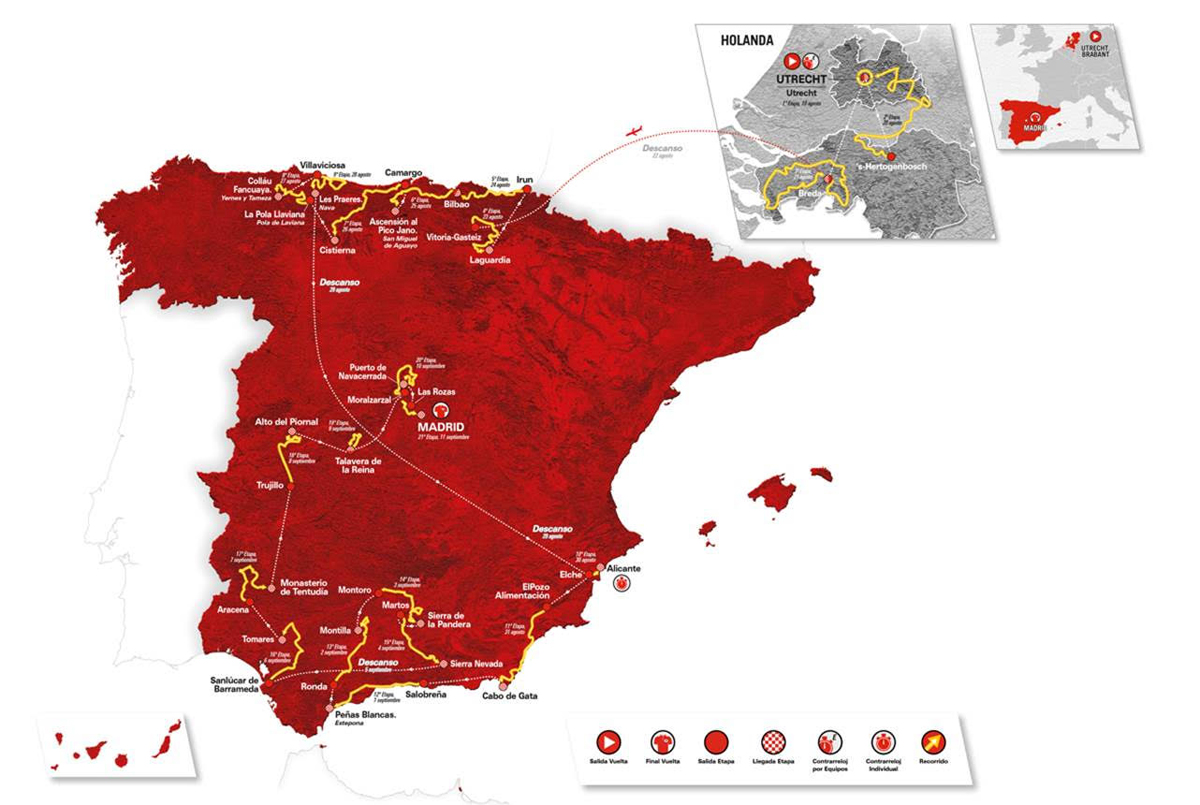2022 Vuelta a España route to start low and end high with seven mountain stages
Plethora of summit finishes gives climbers the advantage yet again

The 2022 Vuelta a España route could be summed up neatly by the time-honoured saying of “If it ain’t broke, don’t fix it” with nine summit finishes spread over three weeks providing ample opportunities for the climbers to dominate yet again.
After last year’s mountain-fest in the final week of the the Vuelta, 2022’s second week looks to be the toughest with three full-blown summit finishes in four days in the Sierras of Málaga, Jaén and Sierra Nevada on stages 12, 14 and 15 that could well decide the overall.
However, stage 20 of the Vuelta through the Sierras of Madrid and with a summit finish at Navacerrada, is notorious for springing major surprises, as happened most recently in 2015 when Tom Dumoulin lost the race there to Fabio Aru.
Other stand-out features of 2022 include three stages in Holland in a Grand Depart originally planned for the 2020 race and which will make Utrecht the first city ever to host stages of all three Grand Tours, after the Tour de France in 2017 and the Giro d’Italia in 2010.
2022 will also be the race’s second year without the Pyrenees and Angliru despite widespread rumours to the contrary, and also sees the return of a full-length mid-race time trial for the first time since 2019.
Furthermore, media predictions of a full homage stage to Alejandro Valverde in the year of his retirement were completely mistaken. A single stage start in his home region of Murcia is the Vuelta’s only direct tribute to the Spanish star, who was unexpectedly missing from the race presentation, too.
As was foreseen, though, the Vuelta will return to Madrid for its last stage after last year’s finish in Galicia, and in keeping with the Vuelta’s predilection for exploring new terrain, of the nine summit finishes, no less than five are completely new.
The latest race content, interviews, features, reviews and expert buying guides, direct to your inbox!
As has been widely published, a mid-length team time trial of 23 kilometres through the streets of Utrecht should provide a first reference point for the GC favourites and the sprinters will get two chances to shine on the flatlands of central Holland before a return to Spain.
Then on stage 5, after a hilly two-day trek through the Basque Country, the first of those unheralded summit finishes kicks in neighbouring Cantabria on the summit of Pico Jano, a 13-kilometre ascent, but with only a few seriously steep pitches.
What will likely prove a first real showdown, though, are the second weekend’s two stages through Asturias. Back-to-back summit finishes at the new challenging ascent of the Collado Fancuaya and then at Les Praeres, where Simon Yates took the race lead for good in 2018, will help clarify the Vuelta GC picture.
After the opening TTT, the climbers second really difficult day will come immediately after a long transfer south and east to Alicante, thanks to a 31.1-kilometre flat time trial likely to favour the specialists and long enough to create some serious gaps.
However, the triptych of Andalucian high mountain stages a couple of days later will put the ball back in the climbers’ court with a vengeance.
While not overly tough, the first summit finish of Peñas Blancas overlooking the Mediterranean on stage 12 is both extremely long and the coastal winds could help further create gaps. Then the ascents to the better known Sierra de la Pandera and above all the interminably rising road to Sierra Nevada 24 hours later – preceded by the brutally difficult Hazallanas climb – could well prove to be the most aggressive mountain moments of the entire Vuelta.
Predicting how the third week of the race could affect the overall outcome of the Vuelta is tricky at best. Stage 16’s flat run through western Andalucia is straightforward enough, but the back-to-back summit finishes that follow at Monasteria de Tentudo and el Piornal are both unprecedented – although neither appears to be excessively hard – and in a remote area of Spain rarely visited by the Vuelta.
Stage 20, with a summit finish on Navacerrada and running through the Sierras of Madrid, is much more familiar terrain for the race, with the rich vein of Vuelta upsets to GC most recently culminating in Tom Dumoulin’s defeat by Fabio Aru. Further back in history, though, Isidro Nozal’s loss of the Vuelta to Roberto Heras, and Robert Millar being overwhelmed by the ‘Spanish Armada’ in 1985 are both classic examples of sudden re-writings of the Vuelta script in the same mountain ranges.
Overall, in any case, after last year’s ‘experiment’ of a final time trial – which didn’t actually change anything – the 2022 Vuelta route represents a return to the usual scenario of multiple summit finishes and a great deal of potential for ambushes and surprises. Which, from a fan’s point of view, has rarely proved to be a bad thing.
Alasdair Fotheringham has been reporting on cycling since 1991. He has covered every Tour de France since 1992 bar one, as well as numerous other bike races of all shapes and sizes, ranging from the Olympic Games in 2008 to the now sadly defunct Subida a Urkiola hill climb in Spain. As well as working for Cyclingnews, he has also written for The Independent, The Guardian, ProCycling, The Express and Reuters.

